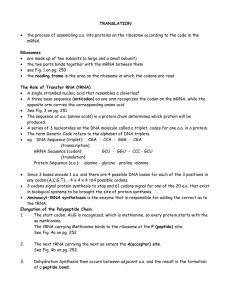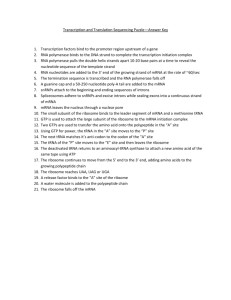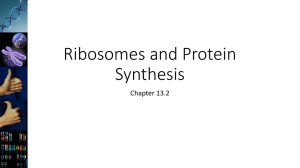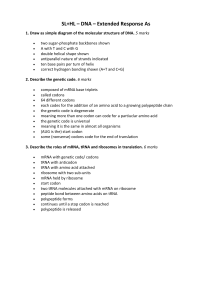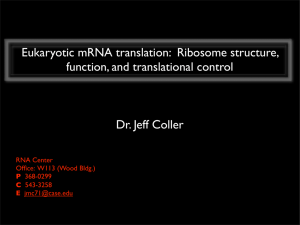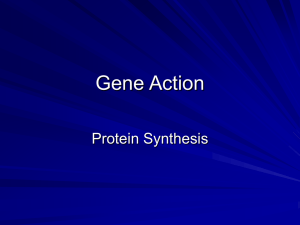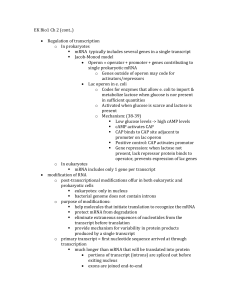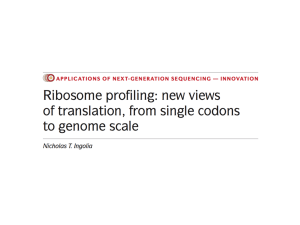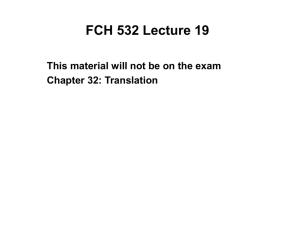Lecture outline
advertisement
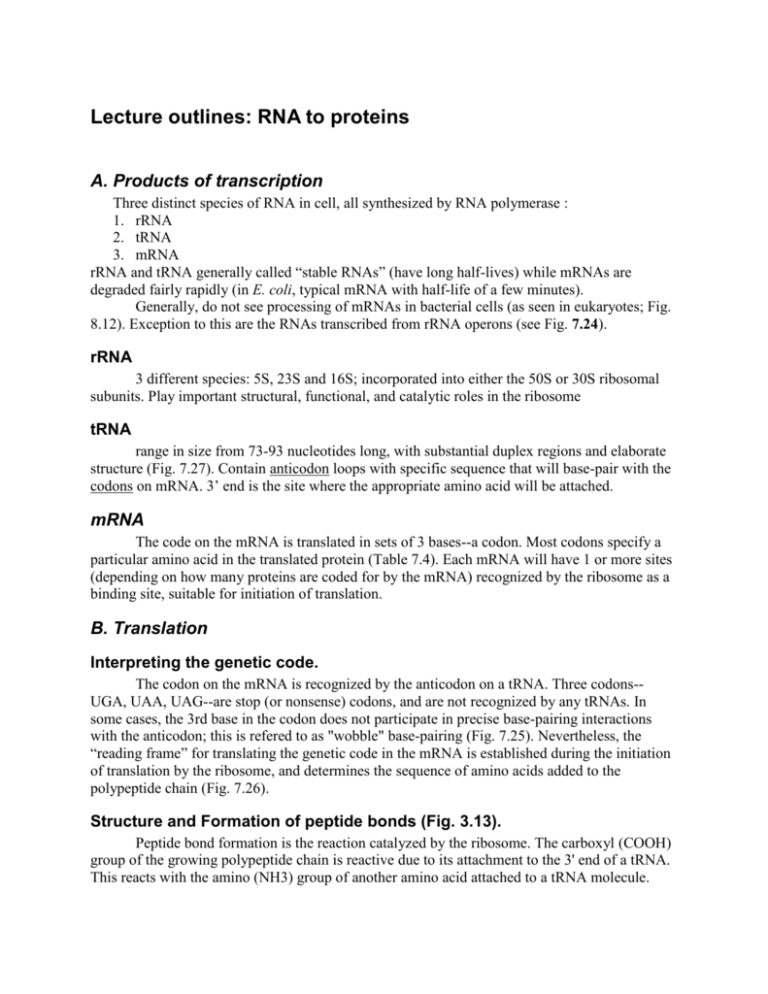
Lecture outlines: RNA to proteins A. Products of transcription Three distinct species of RNA in cell, all synthesized by RNA polymerase : 1. rRNA 2. tRNA 3. mRNA rRNA and tRNA generally called “stable RNAs” (have long half-lives) while mRNAs are degraded fairly rapidly (in E. coli, typical mRNA with half-life of a few minutes). Generally, do not see processing of mRNAs in bacterial cells (as seen in eukaryotes; Fig. 8.12). Exception to this are the RNAs transcribed from rRNA operons (see Fig. 7.24). rRNA 3 different species: 5S, 23S and 16S; incorporated into either the 50S or 30S ribosomal subunits. Play important structural, functional, and catalytic roles in the ribosome tRNA range in size from 73-93 nucleotides long, with substantial duplex regions and elaborate structure (Fig. 7.27). Contain anticodon loops with specific sequence that will base-pair with the codons on mRNA. 3’ end is the site where the appropriate amino acid will be attached. mRNA The code on the mRNA is translated in sets of 3 bases--a codon. Most codons specify a particular amino acid in the translated protein (Table 7.4). Each mRNA will have 1 or more sites (depending on how many proteins are coded for by the mRNA) recognized by the ribosome as a binding site, suitable for initiation of translation. B. Translation Interpreting the genetic code. The codon on the mRNA is recognized by the anticodon on a tRNA. Three codons-UGA, UAA, UAG--are stop (or nonsense) codons, and are not recognized by any tRNAs. In some cases, the 3rd base in the codon does not participate in precise base-pairing interactions with the anticodon; this is refered to as "wobble" base-pairing (Fig. 7.25). Nevertheless, the “reading frame” for translating the genetic code in the mRNA is established during the initiation of translation by the ribosome, and determines the sequence of amino acids added to the polypeptide chain (Fig. 7.26). Structure and Formation of peptide bonds (Fig. 3.13). Peptide bond formation is the reaction catalyzed by the ribosome. The carboxyl (COOH) group of the growing polypeptide chain is reactive due to its attachment to the 3' end of a tRNA. This reacts with the amino (NH3) group of another amino acid attached to a tRNA molecule. Elongation and Termination. Fig. 7.29 The ribosome translocates 1 codon at a time down the mRNA molecule (proceeding from the 5' towards the 3' end of the mRNA). Translation continues until the ribosome reaches a stop codon. The polypeptide chain is attached to the tRNA in the ribosome's P site. Release factors bind to the A site of the ribosome, allowing the bond between the polypeptide chain and the tRNA to be cleaved. The polypeptide and the tRNA are released from the ribosome. The 70S ribosome disassociates into the 50S and the 30S subunits. Initiation & Shine-Dalgarno sequences. Initiation depends on the 30S ribosomal subunit binding initiation factors. This complex binds the mRNA, and identifies the appropriate start codon--usually an AUG codon with a Shine Dalgarno sequence complementary to the 3' end of the 16S rRNA. This complex next binds tRNA-f-Met at the start codon (forming the 30S preinitiation complex). Finally, the 50S ribosomal subunit binds to the 30S subunit, and translation can proceed once a charged tRNA binds to the A site of the ribosome. Antibiotics that target prokaryotic translation See Table on handout. A number of antibiotics specifically target the process of protein synthesis for bacteria but do not affect that process in eukaryotes.
